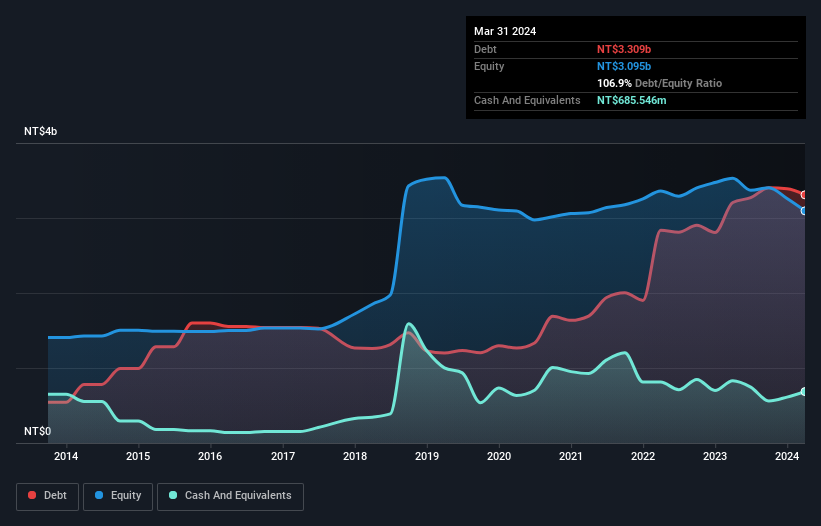
David Iben put it well when he said, 'Volatility is not a risk we care about. What we care about is avoiding the permanent loss of capital.' So it might be obvious that you need to consider debt, when you think about how risky any given stock is, because too much debt can sink a company. We can see that Tbi Motion Technology Co., Ltd. (TWSE:4540) does use debt in its business. But the real question is whether this debt is making the company risky.
When Is Debt Dangerous?
Debt and other liabilities become risky for a business when it cannot easily fulfill those obligations, either with free cash flow or by raising capital at an attractive price. In the worst case scenario, a company can go bankrupt if it cannot pay its creditors. However, a more common (but still painful) scenario is that it has to raise new equity capital at a low price, thus permanently diluting shareholders. Of course, plenty of companies use debt to fund growth, without any negative consequences. When we examine debt levels, we first consider both cash and debt levels, together.
Check out our latest analysis for Tbi Motion Technology
What Is Tbi Motion Technology's Debt?
The chart below, which you can click on for greater detail, shows that Tbi Motion Technology had NT$3.31b in debt in March 2024; about the same as the year before. However, it does have NT$685.5m in cash offsetting this, leading to net debt of about NT$2.62b.

How Strong Is Tbi Motion Technology's Balance Sheet?
We can see from the most recent balance sheet that Tbi Motion Technology had liabilities of NT$1.27b falling due within a year, and liabilities of NT$3.14b due beyond that. Offsetting these obligations, it had cash of NT$685.5m as well as receivables valued at NT$751.1m due within 12 months. So its liabilities total NT$2.97b more than the combination of its cash and short-term receivables.
This is a mountain of leverage relative to its market capitalization of NT$4.10b. Should its lenders demand that it shore up the balance sheet, shareholders would likely face severe dilution. When analysing debt levels, the balance sheet is the obvious place to start. But it is future earnings, more than anything, that will determine Tbi Motion Technology's ability to maintain a healthy balance sheet going forward. So if you're focused on the future you can check out this free report showing analyst profit forecasts.
Over 12 months, Tbi Motion Technology made a loss at the EBIT level, and saw its revenue drop to NT$2.4b, which is a fall of 27%. That makes us nervous, to say the least.
Caveat Emptor
Not only did Tbi Motion Technology's revenue slip over the last twelve months, but it also produced negative earnings before interest and tax (EBIT). Indeed, it lost a very considerable NT$448m at the EBIT level. Considering that alongside the liabilities mentioned above does not give us much confidence that company should be using so much debt. So we think its balance sheet is a little strained, though not beyond repair. Another cause for caution is that is bled NT$61m in negative free cash flow over the last twelve months. So suffice it to say we do consider the stock to be risky. When analysing debt levels, the balance sheet is the obvious place to start. However, not all investment risk resides within the balance sheet - far from it. For example, we've discovered 4 warning signs for Tbi Motion Technology (3 are potentially serious!) that you should be aware of before investing here.
If you're interested in investing in businesses that can grow profits without the burden of debt, then check out this free list of growing businesses that have net cash on the balance sheet.
Valuation is complex, but we're here to simplify it.
Discover if Tbi Motion Technology might be undervalued or overvalued with our detailed analysis, featuring fair value estimates, potential risks, dividends, insider trades, and its financial condition.
Access Free AnalysisHave feedback on this article? Concerned about the content? Get in touch with us directly. Alternatively, email editorial-team (at) simplywallst.com.
This article by Simply Wall St is general in nature. We provide commentary based on historical data and analyst forecasts only using an unbiased methodology and our articles are not intended to be financial advice. It does not constitute a recommendation to buy or sell any stock, and does not take account of your objectives, or your financial situation. We aim to bring you long-term focused analysis driven by fundamental data. Note that our analysis may not factor in the latest price-sensitive company announcements or qualitative material. Simply Wall St has no position in any stocks mentioned.
About TWSE:4540
Tbi Motion Technology
Engages in the manufacture and sale of linear motion products for automation industry in Taiwan, rest of Asia, Europe, and internationally.
Fair value with mediocre balance sheet.
Similar Companies
Market Insights
Community Narratives




